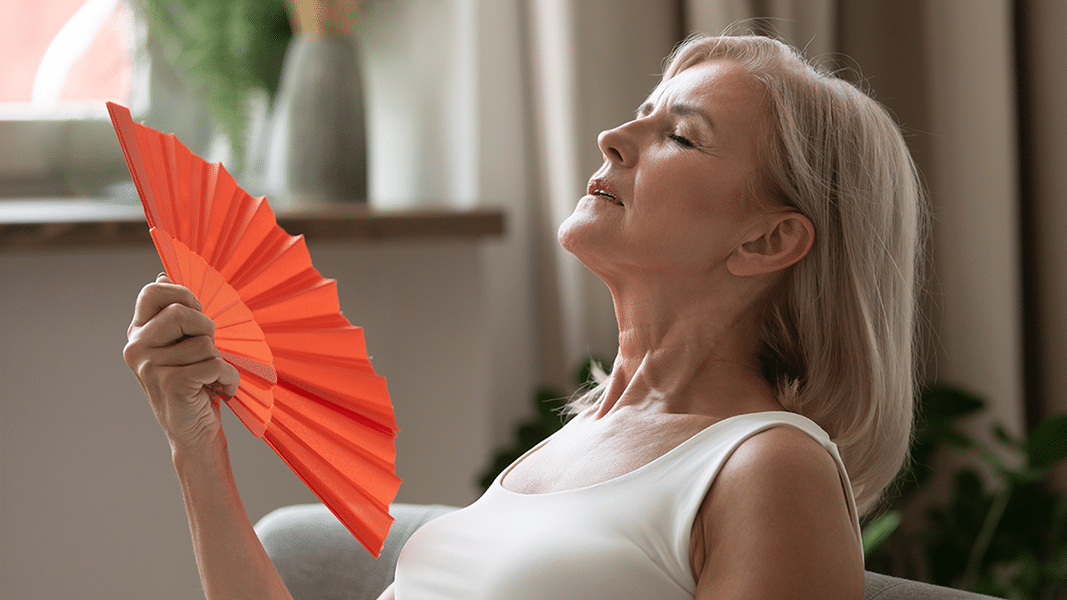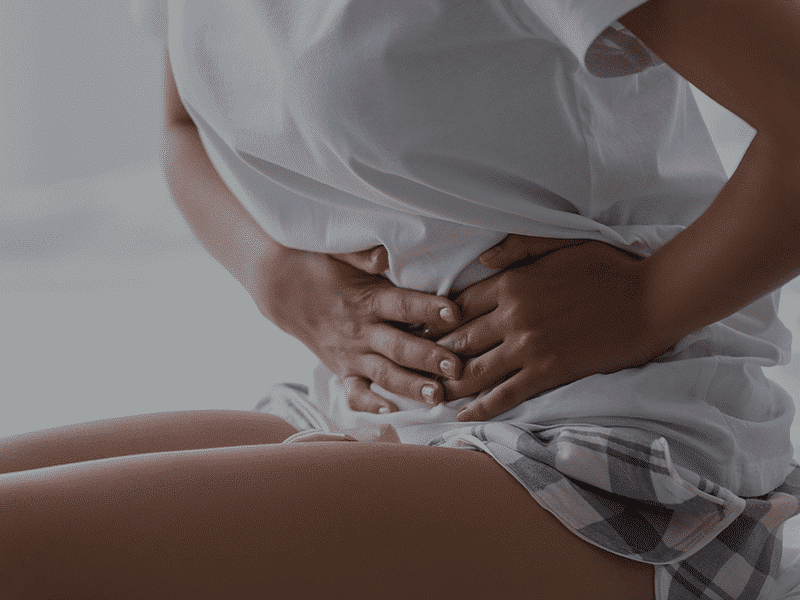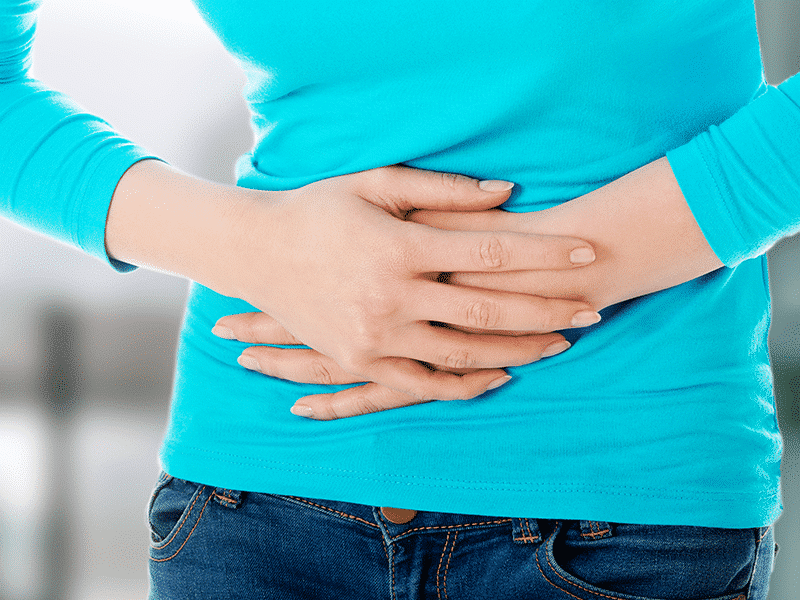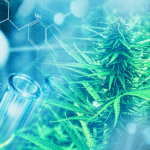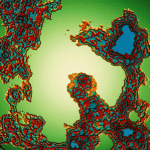Menopause is finally getting its moment in the spotlight after being largely ignored by the medical profession or at best talked about in lowered voices and euphemisms. In the last couple of years it suddenly seems like every female social media influencer between 45-55 is talking candidly about their own personal struggles brought on by plummeting estrogen levels with many highlighting how CBD and cannabis products have helped manage their debilitating symptoms.
In addition to these anecdotal reports, recent scientific data also suggests how increasingly women are using cannabis to make the anxiety, sleep disruption, and night sweats typical of this time of life more bearable.
If you’re male, or a woman under 40, menopause probably seems like some abstract concept. For me it’s telling that despite almost certainly being in perimenopause when I wrote The CBD Book three years ago, I only dedicated a few short paragraphs to the subject. Whereas now when I can officially declare myself truly hormonally challenged, I would probably be able to extend this to an entire weighty tome.
That’s because when perimenopause takes hold and our estrogen levels crash and burn, it’s like an unwanted guest has entered the building. Where once there was good health, balanced mood, a decent night’s sleep, and a clear head, there now resides a rumbling state of anxiety, rage-filled out-of-the-body experiences, deep troughs of depression, sleep disrupted by pools of sweat, and a mind so cloudy that thinking becomes like wading through treacle.
With all this turbulence and dysregulation going on, it shouldn’t be much of a surprise to hear that the body’s master homeostatic regulator, the endocannabinoid system (ECS), is also going through significant changes as women move from their reproductive years towards menopause and beyond. It’s even posited that the ECS may play a role in the health problems commonly experienced by women post-menopause, such as cardiac conditions, osteoporosis, and certain types of cancer.1
From Perimenopause to Menopause
It’s important to point out that menopause is not a disease. It is a natural process when thanks to declining levels of hormone production in the ovaries – primarily estrogen and progesterone – periods gradually cease (on average at the age of 51). For many women, though, perimenopause, the period of transition when hormone levels begin to fluctuate, can actually be more challenging than menopause itself.
“Your hormones can go through changes in a 24 hour period or over a period of months. So, it’s really a tough time. The most common time suicide will occur in a woman’s life is during perimenopause. You just don’t know if you’re coming or going,” explains Genester Wilson-King MD, a Board-Certified Obstetrician, Gynecologist and Founder of the Victory Rejuvenation Center in Florida. She is also currently vice president of the Society of Cannabis Clinicians.
Most women benefit from the protective and mood-enhancing nature of normal estrogen levels until they enter perimenopause. When their estrogen dips, some women who’ve never been prone to low mood or anxiety may experience it for the first time. Or others with a history of mental health issues find their symptoms worsen significantly.
For Julie Durrans in the UK, not only did her existing anxiety disorder worsen during perimenopause, but the hormonal changes also ushered in a general deterioration in her overall health. “As I hit menopause, my joints really started to get aggravated and inflamed, and the dislocations started increasing,” she says referring to the Ehlers Danlos Syndrome that was diagnosed during this period. “The migraines were quite debilitating, three or four a week, and my [general practitioner] put me at serious risk of stroke at that point.”
It’s not uncommon for plummeting estrogen to cause women’s preexisting health conditions to worsen during perimenopause, and for new ones such as fibromyalgia to be diagnosed.2
In addition to the night sweats, disturbed sleep, and increased migraines in the two weeks leading up to her period, Colleen Fisher Tully, 44, a Canadian women’s health writer, suddenly started experiencing vulvodynia – intense pain in her vulva.
“They call it fibromyalgia of the vulva,” says Colleen. “It is just the most horrific thing.”
With this unpleasant plethora of symptoms, it’s hardly surprising that women often experience low libido during both the perimenopause and menopause phases. In between night sweats, insomnia, anxiety, migraines, heart palpitations, and vaginal dryness, swinging from the chandeliers in passionate love-making can lose its appeal.
Hormone Therapy
When menopause finally comes after a year without menstruation, many of the more mood-related symptoms can abate. However, there’s every possibility that some will continue. And without the previously protective levels of estrogen in the body, post-menopausal women are also at higher risk of developing osteoporosis, dementia, and cardiovascular disease.3
Which is why some women turn to hormone therapy (also known as hormone replacement therapy, or HRT), to try and regain some control over their bodies and minds during this period of estrogen decline.
Hormone therapy, which boosts the body’s falling estrogen and progesterone levels, has not been without controversy. One study, which has since been discredited, famously linked HRT to higher risk of breast cancer.4
However, these days transdermal application of bioidentical estrogen is considered safe and for many women works wonders at managing the mood swings and anxiety associated with perimenopause. In fact, studies show that estrogen is more effective than antidepressants at treating depression during this stage of life.5
That said, hormone replacement therapy isn’t for everyone. For those with certain conditions – such as untreated hypertension, current or a history of estrogen-sensitive cancers, and venous thromboembolism – hormone therapy is contraindicated.
Some women simply do not want hormone therapy, preferring to self-manage their symptoms with more natural methods, such as phytoestrogen supplements like red clover or other complementary therapies. Which is where cannabis often comes in.
Estrogen & the Endocannabinoid System
At her clinic in Florida, Dr. Genester Wilson-King tends to recommend cannabis to her patients if hormone treatment isn’t suitable or when some residual symptoms, such as low-level anxiety, remain even after hormone therapy.
“I’ve seen patients throughout most of the hormonal transitions. And I have seen cannabis be very, very helpful,” she says. While Wilson-King is quick to point out that only hormone therapy will actually facilitate balance during the perimenopause/menopause phase, we shouldn’t underestimate the role that the endocannabinoid system plays in women’s hormonal health.
“The endocannabinoid system is very active in the female reproductive tract,” she explains. “The human ovary actually produces the endogenous cannabinoid anandamide, such that in healthy women throughout the menstrual cycle the amount of anandamide circulating is high during the follicular phase from your menstrual period until ovulation. And then the levels are highest during ovulation and lower during the luteal phase.”
Mirroring these anandamide fluctuations, estrogen is also highest up to and during ovulation, tailing off over the rest of the month.
We’re used to thinking of the ECS as the master regulator, but when it comes to the female reproductive system, it appears that estrogen calls the shots.6
“Estrogen regulates the fatty acid amide hydrolase (FAAH), the enzyme that breaks down anandamide,” says Wilson-King, “So when anandamide levels need to be high, estrogen will keep FAAH levels low [which] keeps the anandamide up.”
What remains unclear is why anandamide levels need to be high until after ovulation, but as someone who’s struggled with premenstrual syndrome for most of my menstruating life, it is interesting to note that the red mist I often experience coincides with waning levels of the feel-good endocannabinoid, anandamide.
Post-Menopause Pathologies
The endocannabinoid system and its potential dysregulation is also thought to play a role in the development of pathologies occurring in years after menopause when anandamide levels are low.7
Globally, 30% of women over fifty have osteoporosis, a condition where bones become weakened and brittle. CB2 receptors play a role in healthy bone formation, and in mice models of menopause reduced estrogen is associated with weakened CB2 expression and signalling.8 Conversely, administering estrogen9 inhibits the formation of osteoclasts, the cells that break down bone tissue, a process regulated by CB2 activation.
In the 2021 paper “The Role of Endocannabinoid System in Menopause and Its Related-Diseases,” Italian researchers propose that an estrogen-dependent drop in anandamide levels may partially explain why post-menopausal women have a higher risk of developing cancer (anandamide is known to show antitumoral activity).10
We probably shouldn’t underestimate the double whammy on women’s health when two of their key protective endogenous chemicals start to dwindle. Perhaps it is no coincidence that at this age some women develop illnesses associated with clinical endocannabinoid deficiency.11 On a more personal note, this may help to explain why exercise and the related increase in anandamide12 always improves the pain and discomfort I’ve become used to during my perimenopausal years.
Lack of Interest from Doctors
Both Julie Durrans and Colleen Fisher Tully have found cannabis extremely helpful for improving their perimenopause-related sleep disruption, anxiety, and migraines. For Colleen, THC suppositories, in particular, have brought much welcome relief to her monthly bouts of vulvodynia. Interestingly, Colleen’s experience is supported by a preclinical study suggesting that a THC-mediated decrease in mast cell accumulation may explain the reduction in vulva sensitivity.13
In their respective countries, Julie and Colleen are able to access cannabis for non-menopause related conditions through medical cannabis clinics. Despite informing their clinicians of their perimenopausal status, little interest has been shown in recording the improvements of their symptoms from using cannabis.
“It was as if I didn’t even say anything,” Colleen recalls. “I thought, hmm, that’s interesting, because I know that managing menopause and perimenopause symptoms is one of the best uses for medical cannabis. It’s just the clinical evidence is low, but the anecdotal evidence is overwhelming. And I just thought, ‘Wow, you really missed an opportunity to follow up and to ask me what works and add that data to your clinic.’”
The exceptions to the rule of indifference tend to be women’s health-focussed physicians like Dr. Genester Wilson-King, who combine hormone balancing techniques and cannabis. For Wilson-King this is a win-win situation.
“I have a little saying,” she told Project CBD with a wry smile, “that a hormone-balanced woman who uses cannabis can be a brand new woman.” Perhaps she was referring to the benefits she sees in patients struggling with low libido and sexual dysfunction after incorporating cannabis into their self-care routine.
What’s the Evidence?
Despite research showing CBD and cannabis to be effective at improving key menopause symptoms such as anxiety and sleep disturbance,14 there’s very little menopause-specific data and no clinical trials.
In a June 2022 preclinical study, scientists at Rutgers University in New Jersey report that CBD has protective effects on the health of post-menopausal mice.15 Those receiving CBD-coated peanut butter balls had better bone health, a superior array of gut bacteria, and burned more energy compared with the non-CBD group. This is particularly noteworthy as hormone replacement therapy is not indicated for women over sixty, underscoring that other options are needed. Further research is warranted to see whether the preclinical evidence of CBD’s therapeutic potential for treating post-menopausal disorders such as osteoporosis translates clinically to humans.
A recently published self-reporting survey16 of 258 participants provides a snapshot of how women are using cannabis to manage their symptoms. It found that 67.4% of the women interviewed were using cannabis for sleep, 46.1% for anxiety, and 30.4% for libido. Furthermore, 51% of the women classified their use as mixed medical/recreational, 30.8% recreational only, and 17.7% medical only. The most common modes of consumption were smoking with 84.3% choosing a joint, bowl or bong, followed by edibles at 78.3%, while 52.6% were vaping oil, perhaps reflecting the blurring of lines between recreational and medical use.
But the survey did not shed any light on the efficacy of cannabis products for menopause-related symptoms or the types of cannabis chemovars used, with the authors calling for future longitudinal, observational studies, and clinical trials that include baseline assessments before the initiation of medical cannabis.
A previous Midlife Women Veterans Health Survey interviewing 232 women in Northern California with a mean age of 59.5, found that roughly a quarter were using cannabis to manage their menopause-related symptoms. Again, absent was any data about how successful cannabis was in improving their symptoms.
It would seem that just as in society at large where women are often left to fend for themselves during the challenging transition of the menopause, those choosing to use cannabis and CBD are relying on their ‘whisper network’ of female friends, family, and colleagues or just plain old trial and error to find what works best for them.
At the very least, on the occasions when women of perimenopause/menopause age are patients in cannabis clinics, their hormonal status should be acknowledged and recorded both in terms of the effect it has on their overall health and how cannabis is helping to manage their menopause-related symptoms.
Mary Biles, a UK-based journalist, educator, and Project CBD contributing writer, is the author of The CBD Book (Harper Collins, UK). © Copyright, Project CBD. May not be reprinted without permission.
Footnotes
- M Torella et al. The Role of Endocannabinoid System in Menopause and Its Related-Diseases. Austin J Obstet Gynecol. 2021; 8(4): 1177.
- Jose Luis Neyro et al. Fibromyalgia and menopause. Association or coincidence? Ginecol Obstet Mex 2011 Sep;79(9):572-8.
- Adamah Amouzougan et al. High prevalence of dementia in women with osteoporosis. Joint Bone Spine 2017 Oct;84(5):611-614.
- RD Langer. The evidence base for HRT: what can we believe? Climacteric 2017 Apr;20(2):91-96.
- Barbara L Parry. Optimal management of perimenopausal depression. Int J Womens Health. 2010; 2: 143–151.
- J Maia et al. The endocannabinoid system expression in the female reproductive tract is modulated by estrogen. J Steroid Biochem Mol Biol 2017 Nov;174:40-47.
- Patricia M W Lam et al. Ultra performance liquid chromatography tandem mass spectrometry method for the measurement of anandamide in human plasma. Anal Biochem 2008 Sep 15;380(2):195-201.
- F Rossi et al. The genetic ablation or pharmacological inhibition of TRPV1 signalling is beneficial for the restoration of quiescent osteoclast activity in ovariectomized mice. Br J Pharmacol 2014 May;171(10):2621-30.
- F Rossi et al. The 17-β-oestradiol inhibits osteoclast activity by increasing the cannabinoid CB2 receptor expression. Pharmacol Res 2013 Feb;68(1):7-15.
- Seok-Woo Park et al. Anticancer effects of anandamide on head and neck squamous cell carcinoma cells via the production of receptor-independent reactive oxygen species. Head Neck 2015 Aug;37(8):1187-92.
- Ethan B Russo. Clinical Endocannabinoid Deficiency Reconsidered: Current Research Supports the Theory in Migraine, Fibromyalgia, Irritable Bowel, and Other Treatment-Resistant Syndromes. Cannabis Cannabinoid Res. 2016; 1(1): 154–165.
- Arão Belitardo Oliveira et al. Anandamide Is Related to Clinical and Cardiorespiratory Benefits of Aerobic Exercise Training in Migraine Patients: A Randomized Controlled Clinical Trial. Cannabis Cannabinoid Res. 2019; 4(4): 275–284.
- Beebie Boo et al. Tetrahydrocannabinol Reduces Hapten-Driven Mast Cell Accumulation and Persistent Tactile Sensitivity in Mouse Model of Allergen-Provoked Localized Vulvodynia. Int J Mol Sci. 2019 May; 20(9): 2163.
- Scott Shannon et al. Cannabidiol in Anxiety and Sleep: A Large Case Series.Perm J. 2019; 23: 18-041.
- Ke Sui et al. Cannabidiol-Treated Ovariectomized Mice Show Improved Glucose, Energy, and Bone Metabolism With a Bloom in Lactobacillus. Front. Pharmacol., 21 June 2022 Sec. Integrative and Regenerative Pharmacology.
- Dahlgren, M. Kathryn PhD et al. A survey of medical cannabis use during perimenopause and postmenopause. Menopause: September 2022 – Volume 29 – Issue 9 – p 1028-1036.
Recommended Readings
CBD & Cannabis for Endometriosis
Is endometriosis caused by endocannabinoid deficiency and could cannabis be an answer?
Loss of Cannabinoid Receptors in Adenomyosis
Adenomyosis is a menstrual complication that affects one in five women.
New Study: Cannabis Is Effective for Fibromyalgia
Treating the root cause of refractory pain.

